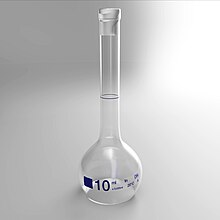volumetric flask
Flask (sometimes volumetric flask ) are used mainly for the preparation and storage of standard solutions with very precise concentrations used. Since they are calibrated for inlet (or pouring), they are not volumetric instruments .
Volumetric flasks do not have a scale, but have a single ring mark that is drawn all the way around the neck in order to avoid reading errors. The filling is correct when the lower meniscus of the liquid touches the ring mark, as is usual with burettes. When looking straight at the volumetric flask, the lowest bulge of the liquid (meniscus) should lie directly on the ring marking. Water is always pushed slightly upwards by adhesive forces with the edges of the glass, so the mean liquid surface is selected for the reading. The volumetric flasks are calibrated by the manufacturer to a water temperature of 20 ° C. Water has the highest density (ρ = 1,000 g / cm³) at 4 ° C, at 20 ° C the density is slightly lower than at 4 ° C. Class A volumetric flasks show the most precise results (up to 1/4000 accuracy). However, there are also class B volumetric flasks that also achieve high accuracy. There may be deviations depending on the manufacturer.
Preparation of a customized solution
It is important to ensure that the flask is completely clean, especially completely free of grease, because otherwise the water on the wall of the vessel will not be completely wetted (tear formation). This can lead to errors in the ‰ range. All solutions that are prepared must be filled up exactly to the ring mark. The temperature of the distilled water is checked beforehand; it should be around 20 ° C. Often 1 or 0.1 mol or 1 or 0.1 equivalent of substance is weighed out with a scale in a beaker; the substance is then completely dissolved and transferred to the volumetric flask with distilled water - without a single drop getting next to the volumetric flask. The beaker is rinsed with more distilled water and transferred to the volumetric flask. The volumetric flask is then filled up to the calibration mark with a squirt bottle. With a Pasteur pipette, the last amount of liquid can be poured in exactly to the calibration mark. Then the flask is shaken and the solution is ready. In spite of all care, the factor should be determined for custom-made solutions . This factor determination should also be carried out on purchased solutions after they have been standing for some time, because the concentration of the substance to be measured may have changed due to evaporation or chemical reactions in the air space above the solution .
Others
With very precise volumetric flasks with a capacity of 1000 ml, an accuracy of up to 1 / 4,000 can be achieved; they are often used to produce standard solutions in titrimetry. Burettes achieve a maximum accuracy of 1/1000. Smaller, calibrated volumetric flasks can be used for the first density determination of solutions if pycnometers are not in stock. Since volumetric flasks are calibrated for pouring, several volumetric flasks can be used to create very low-concentration solutions through multi-stage dilution. A specific volume of a more concentrated solution is poured into a volumetric flask and then topped up with a solvent. This process can be repeated several times until the desired concentration is reached. When specifying the concentration, the error propagation should be taken into account.
Volumetric flasks are rounded at the top so that any gas bubbles that may form can more easily escape from the solution. However, if there are gas bubbles in the solution, the volumetric flask must be swiveled slightly so that the bubbles rise.
The narrow neck results in a high level of adjustment accuracy for the solvent volume. In addition to volumetric pipettes and burettes for analysis, volumetric flasks are the most precise volumetric instruments in the laboratory.
Volumetric flasks are calibrated for inlet (or sprue), i.e. This means that the amount of liquid absorbed corresponds to the volume information printed on it, taking into account the error that is also specified. When the liquid is transferred to another vessel, a small part of the liquid always remains in the volumetric flask, so that the amount of liquid transferred is less than the content.
Heating volumetric flasks can lead to a loss of measurement accuracy .
Volumetric flasks with a volume of 5 milliliters to 10 liters are customary. They usually consist of borosilicate glass , polypropylene or polymethylpentene , but only glass devices can be calibrated .
literature
- DIN 12664-2: 1981-01 Laboratory glassware; Volumetric flask with a mark, volumetric flask with threaded connection , January 1981
- DIN EN ISO 1042: 1999-08 Laboratory glassware - Volumetric flasks (ISO 1042: 1998); German version EN ISO 1042: 1999 , August 1999
Individual evidence
- ↑ a b Walter Wittenberger: Chemische Laboratoriumstechnik , Springer-Verlag, Vienna, New York, 7th edition, 1973, pp. 83–84, ISBN 3-211-81116-8 .
- ^ Gerhard Meyendorf: Laboratory equipment and chemicals. People and knowledge Volkseigener Verlag Berlin, 1965, pp. 17 and 39–40.
Web links
- Entry to volumetric flask. In: Römpp Online . Georg Thieme Verlag, accessed on September 22, 2017.

